Month: January 2008
Sadly Missed
Cathy and I are very sad today. We are mourning the passing of a dear friend in comics fandom, brother of Bea Barrio-Buchman and brother-in-law of our friend Ed Buchman (publisher of Little Lulu fanzine, the Hollywood Eclectern): Mickey Barrios. He died last night of complications of pneumonia and a chronic cough he had suffered from for several months. Mickey had a small business for years dealing in new and old comic books at sizable discounts. The business went under the name “BEA”, same name as his sister, but it could have been an abbreviation, Mickey never told us.  He lived in a charming little attic, surrounded by books, in Bea’s family’s house and was a very quiet and private person. Comics were his window on the world and, through them, he made a lot of friends. He knew many folks in fandom; knew all the dealers at the San Diego Comic-Con. I still prize a book I bought from him on cartoons: “Careers in Cartooning” by Lawrence Lariar. Mickey was a big booster of my wife’s comic book: Mad Raccoons by Cathy Hill (published by Mu Press, 1991-1996). He wrote Cathy encouraging letters when a new issue came out, calling it a “truly adult” comic, about relationships, psychoses and neuroses. He was very generous with his time, and always carried Mad Raccoons in his monthly comic lists. Cathy always said that Mickey’s comments about her raccoons were some of the most astute she ever received and valued them. This is an especially sad time for Mickey’s sister, Bea, as her mother passed away shortly before the holidays last year. If you knew Mickey, or would like to write a letter, just go to Ed Buchman’s website (there is a link to it on this page).
I have posted almost a week’s worth of Marvelous Mike strips: 3/12/1956 to 3/16. This is to bring the strip up to posting a week at a time as originally published. Also there is a scan of the first Mike strip, kindly supplied by Dean Mullaney (through Craig Hodgkins, who has a blog on Joe Penner, link at right). Dean thinks there was a Mike Sunday page, maybe he will send us one? Also I have posted the first two pages of the Jim Tyer Felix story: “Fair Weather Enemies” from Dell Felix #3. These are real scans, this time. I kind of like to think that Mickey Barrio would have enjoyed reading these. This post is for him. See you next time.
More Mike! San Pascual Stables! Tytla and Tyer!

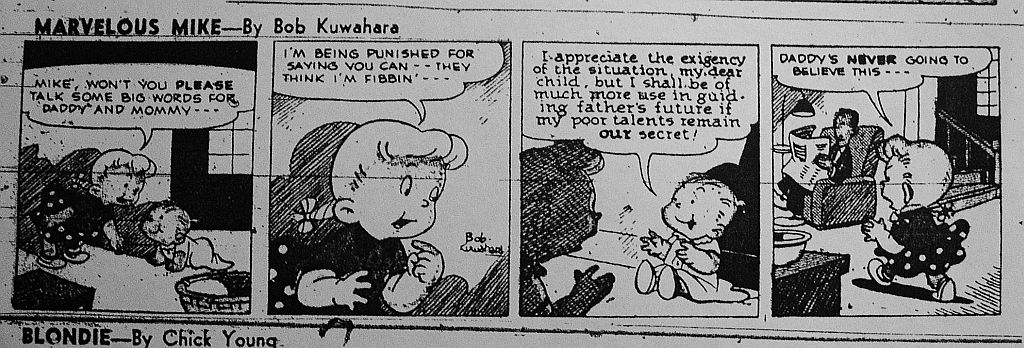

 Here are the last two pages of the Tyer story from Felix the Cat #2, and the next three strips in the Marvelous Mike saga. Note how in the last page and the last panel of the Felix story, Felix’s dialog has been re-lettered. Maybe his original comment was too ribald!  In episode #4, Mike first displays his precocity with a quotation from Shakespeare. His sister Merrie is the only one in the family who knows Mike’s secret at this point. Bob Kuwahara did another comic strip in the late 1940s; “Barker Bill”, featuring the Terrytoons host from early television days who made his screen debut in “Happy Circus Days” (1942). I don’t have much information about the “Barker Bill” strip, I might be able to dig up an example one of these days. Next time we should be getting some better quality scans on the Felix comics.
   Cathy and I painted a beautiful old barn and some of the horses stabled there last Thursday. It was a beautiful day at the San Pascual stables in South Pasadena, after cold and wet weather discouraged outdoor painting the last couple of weeks. Southern California is really horse country. There are a lot of dedicated riders and owners who maintain stables in all sorts of out of the way places. We found another stable just a few blocks from the San Pascual that had a lot of free-range chickens running all over it! At the San Pascual stables there were some beautiful girls riding English, complete with habit and saddles, and still more girls exercising thoroughbreds and sorrels right next to the barn where we were painting. Cathy got a good start on an oil of the barn with two horses in front of it. I did a watercolor which our guest crit master, Lynn Fearman, called “animated”! She said this without knowing I did the painting! I did a study of Lynn and another painter standing in front of the barn with a couple of horses peeking out. I also attempted another study of a little clothesline with the sun streaming through the wash, I didn’t get it on the first try, but it’s such a beautiful subject I might try it again.
      I’ve been watching a lot of color Terrytoons lately. I like the fact that grand opera had such a big influence on the story structure of the Terrytoons, almost from the beginning of the Audio Cinema days. Paul Terry or maybe John Foster must have been opera fans. The singing in some of the Mighty Mouse cartoons is pretty good and fun to listen to, the music in Carmen’s Veranda, for instance, is certainly nothing to be ashamed of. I wonder if Phil Scheib did all the arranging and composing for the choral parts, or if he got help from a friend at the Met. There is something touching about the little jockey’s song, “You Look Pale and Worried…” as he sings to the Colonel’s daughter in My Old Kentucky Home (1946). The operetta form almost stands in for personality (but not quite). Mighty Mouse eventually developed into a remake of the “Fanny” cartoons from 1933 (The Banker’s Daughter), with Oil Can Harry re-designed as a cat, and Pearl Pureheart and Mighty taking over the roles of Fanny and Strongheart.
It’s interesting to see how highly polished the studio’s animation looked when Bill Tytla was working there (1944), and how raggy and unkempt the animation became by 1949, when Jim Tyer’s animation was starting to bloom. Tytla not only animated the famous “cat becomes Mr. Hyde” sequence in Mighty Mouse Meets Jeckyll and Hyde Cat, but also many of the singing hippo shots in Carmen’s Veranda, along with a few scenes of Carmen the girl cat herself. I think Tytla also did some of the great dance animation in the Gandy Goose cartoon, Aladdin’s Lamp (1943), with Sourpuss and the little Chinese cat. Jerry Beck posted part of A Wolf’s Tale a few weeks ago, and that also features Tytla doing the wolf skipping through the forest. This cartoon re-uses some of George Gordon’s animation from The Wolf’s Side of the Story (1938).
   Mike Barrier often compares the Tom and Jerry cartoons with the Terrytoons. I saw a Dingbat cartoon, All This and Rabbit Stew (1950), which uses the same bees in the mouth gag from the Tom and Jerry Tee For Two (1945). The Dingbat (a crazy little bird) sets a whole hive of bees on two hapless buzzards; one buzzard hides in a lake to escape the bees and breathes through a reed. The Dingbat makes like Jerry the mouse and chunks a funnel in the end of the buzzard’s reed above the water line. The bees then fly into the funnel just like in the Tom and Jerry, except they are animated by Tyer in an almost abstract fashion. Unlike Tee For Two, there is no dramatic pause before the bees start stinging. Instead the next scene is a helicopter shot of the lake. The buzzard animated by Tyer, bursts out of the water and gives out with a series of screams animated in staggered timing coming closer and closer to the camera; so crazy that it almost doesn’t scan! Tyer was kinder to his buzzard than Ken Muse was to Tom, there are no bees actually in the buzzard’s mouth, they just sort of radiate out of the buzzard’s body like so many insect shaped sweat drops. The results are not as funny as Tee For Two, but entertaining in a loopy, lopsided way.
Looking at Tyer’s animation frame by frame from some of these Terrytoons is often jaw-droppingly startling (and funny). There is another Dingbat cartoon, Sour Grapes (1950) with the most primitive child-like drawings of the Dingbat doing a laugh, then going into a take at the fox who is just above him. Tyer couldn’t draw the Dingbat’s beak from the front, and apparently had no idea how his bill joined on to his head, but the animation works anyway! In Tyer’s world, the drawings are just way stations in the action stream, it’s what happens between the frame changes that’s magic. In Cat Happy (1950), a Little Roquefort cartoon, Percy the cat’s happy takes when he’s high on catnip are just abstract pinwheels when looked at a drawing at a time. Percy’s head and body literally become just a pinwheel shape before turning back into the cat. At speed this reads as just an accent, all on ones, of course. He uses the same device with Roquefort doing a series of amazed takes at Percy as the mouse floats in mid air, becoming an abstract pinwheel before each of his poses. When you see the tendency toward abstraction in Tyer’s work, and how incapable he was of drawing characters from certain angles, it’s no wonder that Gene Deitch’s design theories were such a natural fit for his brand of cartooning. Terrytoons certainly didn’t create too many vivid characters, but it can be fun to watch them for the animation tricks on display. It’s interesting that at Terrytoons, an incredible draftsman like Bill Tytla and an abstract expressionist like Tyer are equals. Given no real personalities to work with, Tytla and Tyer trade on their skills at making action interesting to look at, Tytla with his careful control of volumes (Carmen and the wolf) and realistic handling of weight (that hippo woman), and Tyer with his complete abscense of volume and completely funny drawings (Dingbat and Percy). They both entertain.
Marvelous Mike!
Thanks to some new software that lets me process pictures more efficiently, here is my favorite comic strip from the St. Louis Post-Dispatch: Marvelous Mike! Written and drawn by Bob Kuwahara; the first episode ran in the Post, March 5, 1956. Here are the first three dailies from Post-Dispatch microfilm. Keep in mind that the Post was one of the few papers in the 1950s that ran their daily comics in color. The downside of that is that the colors, especially red, read as almost solid black on the microfilm. That, and the usual lateral scratches on the film, will mar this reprint, but given the strip’s rarity, I thought it was worth a shot. Mike was an orphan, left on the family’s doorstep in the first episode;in the third strip, Dad inadvertently names the baby: “..for the love of MIKE!” Wife: “That’s it dear, Mike!” Mr. Kuwahara was at the Disney studio in 1932 and may have been involved in the early development of “Baby Weems”.Mr. Kuwahara was involved in Snow White story meetings. There is quite a resemblance between Mike and Weems, as subsequent episodes will reveal.
I was eight when Mike appeared in the Post, evidently the ONLY paper in the USA which carried the strip. If you look at Mr. Kuwahara’s bio above, he created a strip named “Miki” which ran from 1945-1950. Perhaps “Marvelous Mike” is a re-worked version of “Miki”, translated from the Japanese? I notice a strong stylistic resemblance between the drawing in “Mike” and the Gandy Goose and Sourpuss comics of the St. John/Pines era, maybe Mr. Kuwahara drew those as well. There is so much I don’t know about Mr. Kuwahara, he was in an internment camp during WW II, and created Hashimoto-San for CBS Terrytoons in the early 1960s. Sources disagree about when he passed on, some say 1964, others 1966. He must be one of the first Japanese immigrants to do a US comic strip, and work in the pioneering days of sound motion picture cartooning. “Marvelous Mike” appealed to my sense of fantasy very strongly at eight years of age. The adventures of a genius baby must have been my fundamental power fantasy, after all, Mike was smarter than his “father”, and I longed to be smarter than my dad! Perhaps Mike came from another planet, the strip doesn’t reveal that. I loved this comic strip so much, that I clipped it out of the Postand lovingly saved it in a special box. I wanted to share my run of the strip with fellow classmates, so I foolishly took the box to school. It was stolen from me when I wasn’t looking, and I never found out who took it, and never got it back. Now all these years later, my brother in St. Louis is slowly and carefully copying a run of “Marvelous Mike” from St. Louis Post-Dispatch microfilm. Thanks, pal, for all you do, we all owe you one. Bear with me on the first six strips, as I copied these myself a long time ago. My brother’s copies are much better and larger. More Tyer Felix is in store, as well, from better scans. Happy New Year to all the world!
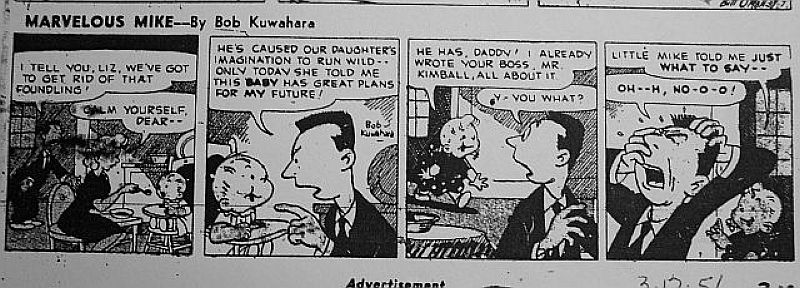
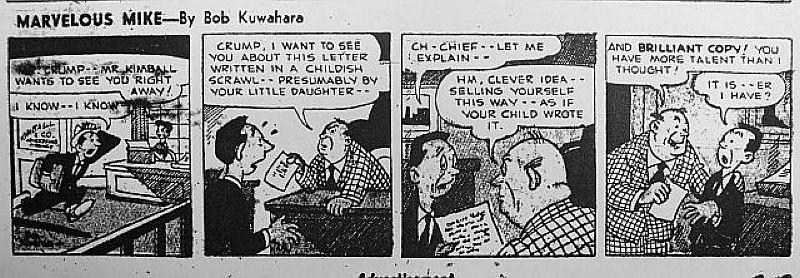
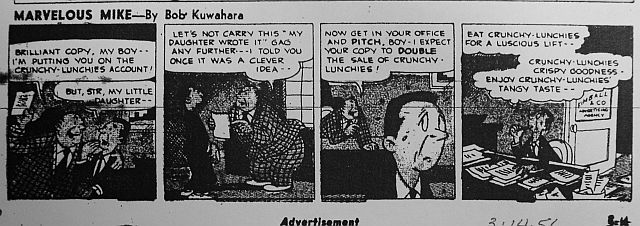
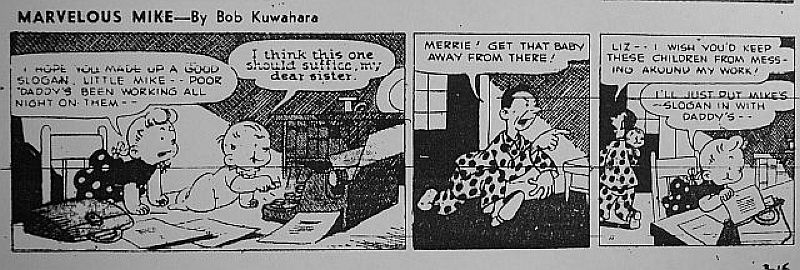
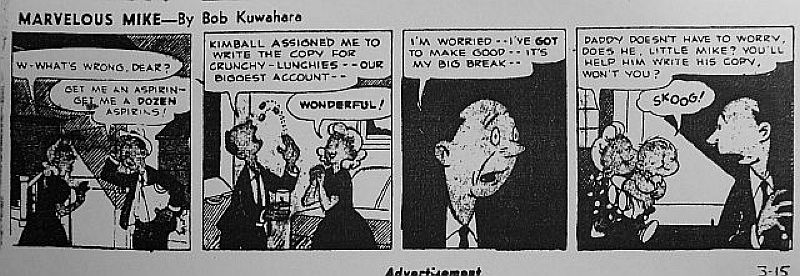

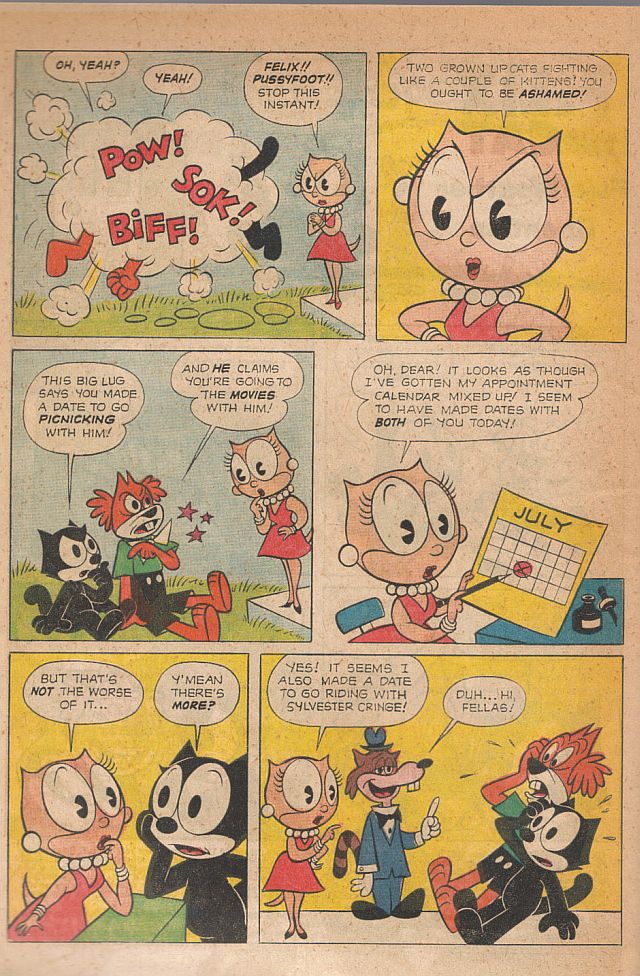

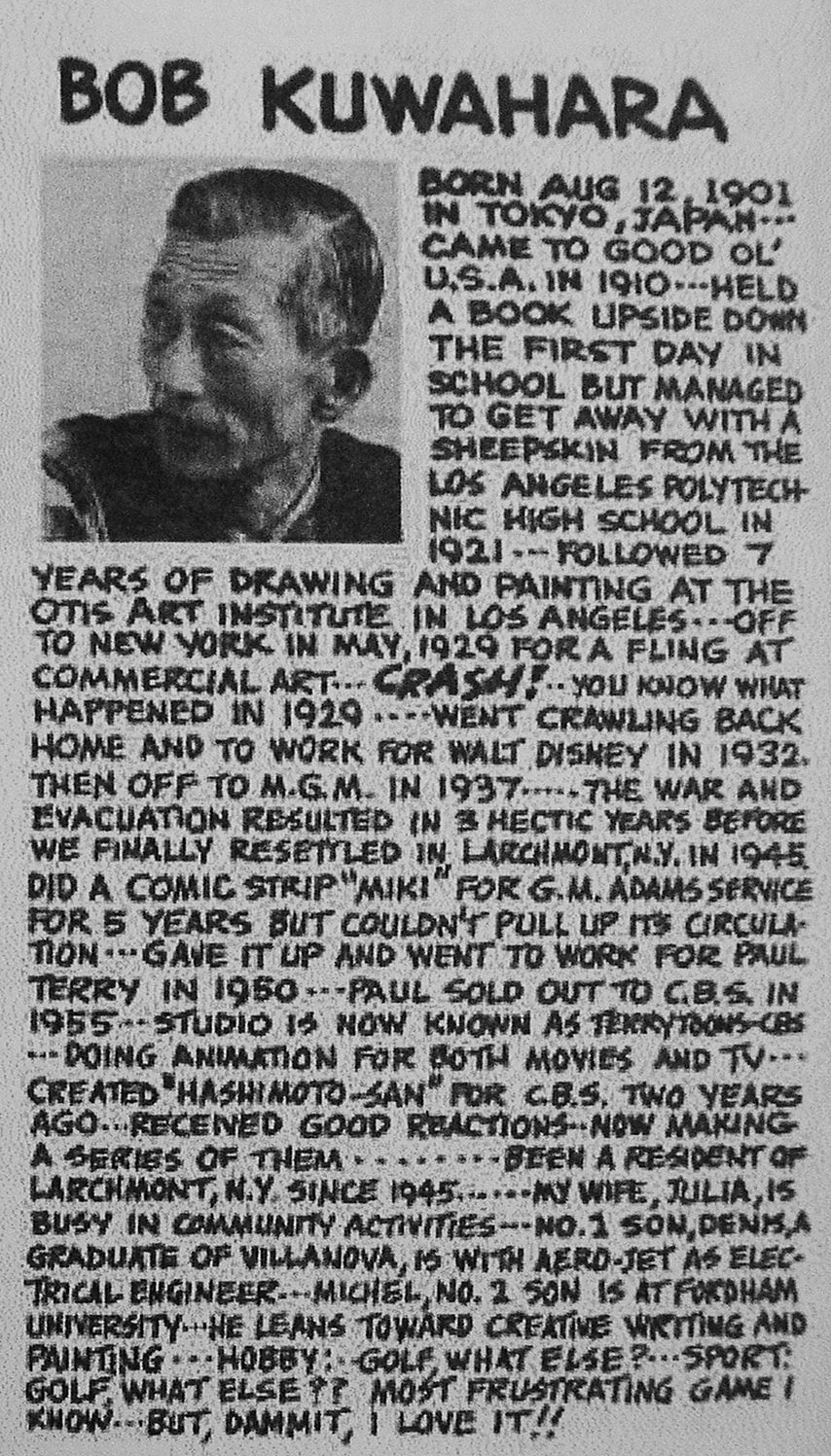



Tracey, Tracey, Tracey
January 29, 2008
Uncategorized
3 Comments
Mark
Through the kindness of my friend Vincent Davis, I received a copy of the new biography of Charles Schulz, Schulz and Peanuts: A Biography by David Michaelis. It took nearly two months for me to finish reading it, and I did not read through all the “Source Notes” at the end of the book. Do you see the drawing of Snoopy above that is signed by Charles Schulz? That inscription is on my copy of the first “Peanuts” book (16th printing), which was autographed in 1972 at the San Diego Comic-Con, when they held it at the El Cortez Hotel. I knew Mr. Schulz was going to attend, so I brought my copy of the book with me. Imagine my joy when I saw him striding quickly across the hotel lobby! I ran after him with book in hand, and breathlessly asked him to sign it for me. At first he looked anything but affable, frowning as if I’d caught him in mid-thought. When he saw the book, however, he brightened up. “You know, there aren’t many of these around!”, he said and started to sign it. Before he could make a mark, I piped up: “Can you draw a Snoopy for me?”, Mr. Schulz looked a bit stormy again, but without a word, drew what you see here in about 10 seconds, then handed me the book and walked away so quickly that I don’t know if he heard me say: “Thanks, Mr. Schulz, I’ve loved your work all my life…..” It’s true, I really do love the “Peanuts” strip, and especially Snoopy. My brother and I loved our family dogs, Sparkle and Schatzi when we were little, and Snoopy took the concept of the intimacy of life with the family dog and enlarged it until Schulz had him fighting The Red Baron upon his imaginary Sopwith Camel Doghouse. I like the early long-nosed Snoopy, which evidently Schulz disliked. This version of Snoopy looked especially funny when he was running around frantically chasing rabbits with wide open mouth, at the insistence of Freida, who thought he was getting soft.
Schulz and Peanuts created a bit of controversy. It paints a picture of Charles Schulz that is a bit more “fleshed-out” (and I do mean flesh) than his family are comfortable with. Monte Schulz, himself a writer, really took exception to the portrayal of his father as a “hands-off” parent, who let his first wife, Joyce, run the house and discipline the kids, while he turned out the strip. Michaelis also shows us a Charles Schulz uncomfortable with displays of affection with his wife and children, insecure about his talent and the merits of his work, and most revealing of all, a human male who had affairs outside of his marriage(s). Only one of these affairs, with Tracey Claudius, seems to have ended up in bed. Schulz certainly changed from the modest barber’s son, art instructor and God-fearing, St. Paul Minneapolis street corner preacher who didn’t drink and always felt left out of everything in school and personal relationships.I found the chapters from #17, “The Call of California” to #28, “Dailies Done” to be the best part of the book. Charles Schulz, who always thought of himself as unattractive and unimportant, found that as the Peanuts empire grew, his influence (and money) made him irresistible to women. The book (in the chapter “Arena”) goes into quite a lot of detail about Tracey and Schulz, and also gives us insight into how his relationship with his first wife, Joyce, was one of the dynamics that informed the 1960s heyday of the strip. Joyce was really Lucy, to simplify. She was the great builder in the family, building two houses and two studios for “Sparky”, including One Snoopy Place in Santa Rosa, and the Redwood Empire Ice Arena, where Schulz was a denizen of the Warm Puppy Cafe.  If you are ever in Santa Rosa, by all means visit the Charles M. Schulz museum and the Ice Rink, I think I love those places more than Disneyland. Eventually, Schulz walked out of his marriage with Joyce, they were in constant conflict over their children, and the affair with Tracey, which Joyce discovered by looking at the Telephone bills. Michaelis draws interesting parallels between happenings in Schulz’s life and the strip, after his marriage to Jeannie in 1973, for instance, Lucy became a much softer character as the inspiration for her feisty attitude, Joyce, lost her influence. Jeannie was much more willing to just let “Sparky” be himself, even indulging his many phobias, such as fear of travel (Jeannie just did a lot of travelling by herself with the children while Sparky stayed in his studio). There were a lot of ironies in Schulz’s life, for all his self-deprecation and low opinion of himself and his work (“I’ll never be Andrew Wyeth”), he was enormously competitive, he felt like Peanuts had to “win” the comics page each day, in comparison with the other strips, or he wasn’t doing his job. He was a very tough negotiator with United Feature Syndicate when he won full rights to the strip, threatening: “…I just want control so you guys can’t ruin it (Peanuts)….I want to own this thing….So either I get my way—exactly what I want—or I’m going to quit.” Wow, that’s no Charlie Brown, that’s Uber-Lucy! What brought this change of heart about? Jim Davis and Garfield! In 1985, Garfield was beginning to be almost as profitable a property to United Feature as Peanuts! Schulz was unhappy with the syndicate’s promotion of the cat at the expense of his dog (Snoopy), so a new era in the business of Peanuts was born. And what a business, at one point in the 1990s, Schulz earned about four thousand dollars a day from his enterprises, not so much the strip, but all the merchandise.
Again, I have a very great love for Peanuts, I even tried to make an animated cartoon with the characters when I was nine. My version of Peanuts looked more like a Hanna-Barbera cartoon, with Snoopy doing a spinning leg exit just like Huck Hound. I had a very warm, friendly feeling about the strip in those days, I liked Charlie Brown, and identified with his longing to be liked. I thought Lucy and Schroeder were especially funny together, and of course, Snoopy, that wonderful dog, a friend forever! It’s really the strip that is the true legacy of Charles Schulz. The animated shows were very well done in the early years (especially the old Tennessee Ernie Ford show openings and the Christmas show) and I liked the children’s voices and Guaraldi jazz scores. I hope, however, that the strip will be kept in print always, and that folks will get to know the characters on the printed page. This may be a forlorn hope, because the experience of living with Snoopy day by day, the feeling that he was a living character from the newspaper that fell in the front yard every morning may be impossible to re-create in book reprints where you see many strips all at once.  I’m glad Charles Schulz lived on Earth, and gave me (and us) such a wonderful reading experience every day. He did it all himself, too, except he couldn’t finish the lettering in the third panel of the last daily he did (Dec. 31st 1999), Paige Braddock, his office assistant, did the lettering for him from a computer font, because Schulz was not feeling good enough. I even love the “Spike and Olaf” era of the strip, when Jeannie’s sanguine influence may have inspired an explosion of new characters. Spike is such a lonely character, living in Needles with only cacti for friends. A lot of Charles Schulz’s feelings of loneliness and isolation are in Spike, and maybe his childhood memories of Needles, California.
Michaelis’s book isn’t perfect by any means, he comes to some rather strange conclusions. On page 563, for instance he states “..only after the master was gone could South Park and Family Guy be recognized as ‘a kind of joyous unleashing of the weird, retentive genius of Charles Schulz.’ ” The quotation within the sentence is from Garry Trudeau. I don’t feel comfortable laying such questionable fare as South Park and Family Guy at Schulz’s doorstep. I think he might have been a little uncomfortable with the taste in some of the jokes in those shows. Schulz’s characters might have had their darker moments, but the strip was always something you wouldn’t hesitate to show to your mother or grandmother (both my grandmas loved Peanuts. They both thought that Charlie Brown’s name was “Peanuts”). I wish Michaelis had done a chapter on Schulz’s working methods, what pens he favored, the paper he used, did he have his children pose for him sometimes (they supplied very little of the humor). The details of Charles Schulz’s family life are the real centerpiece of the book, and the strips that Michaelis picked to illustrate some of the incidents, like the strips that allude to his romance with Tracey, are well-chosen and revelatory, though reproduced a bit too small. If Joyce had been reading Peanuts as closely as the telephone bills, maybe she would have known that Sparky was getting romantic about another woman much earlier!
If Michaelis had written a more Schulz family-approved book, with more details about the creative side of Peanuts, and less detail about his love life, would the book have been any better? I might have liked it better, but the book is very interesting, and it wouldn’t be as compelling a read (especially in the last third) without Tracey, et. al. This book is obviously written with the adult, general reader in mind who wants to read the darker story behind the strip, whether everything in there is the absolute truth or not. I can’t even say I especially recommend this book, I enjoyed reading it, but my copy of the book was a gift, after all. So READ IT and STOP WHINING, YOU STUPID BEAGLES!